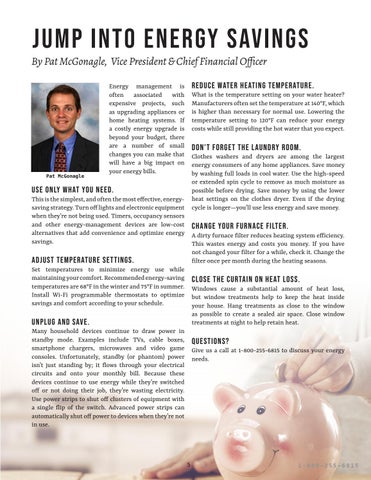Jump into energy savings By Pat McGonagle, Vice President & Chief Financial Officer
Pat McGonagle
Reduce water heating temperature.
Energy management is often associated with expensive projects, such as upgrading appliances or home heating systems. If a costly energy upgrade is beyond your budget, there are a number of small changes you can make that will have a big impact on your energy bills.
What is the temperature setting on your water heater? Manufacturers often set the temperature at 140°F, which is higher than necessary for normal use. Lowering the temperature setting to 120°F can reduce your energy costs while still providing the hot water that you expect.
Don’t forget the laundry room. Clothes washers and dryers are among the largest energy consumers of any home appliances. Save money by washing full loads in cool water. Use the high-speed or extended spin cycle to remove as much moisture as possible before drying. Save money by using the lower heat settings on the clothes dryer. Even if the drying cycle is longer—you’ll use less energy and save money.
Use only what you need. This is the simplest, and often the most effective, energysaving strategy. Turn off lights and electronic equipment when they’re not being used. Timers, occupancy sensors and other energy-management devices are low-cost alternatives that add convenience and optimize energy savings.
Change your furnace filter. A dirty furnace filter reduces heating system efficiency. This wastes energy and costs you money. If you have not changed your filter for a while, check it. Change the filter once per month during the heating seasons.
Adjust temperature settings. Set temperatures to minimize energy use while maintaining your comfort. Recommended energy-saving temperatures are 68°F in the winter and 75°F in summer. Install Wi-Fi programmable thermostats to optimize savings and comfort according to your schedule.
Close the curtain on heat loss. Windows cause a substantial amount of heat loss, but window treatments help to keep the heat inside your house. Hang treatments as close to the window as possible to create a sealed air space. Close window treatments at night to help retain heat.
Unplug and save. Many household devices continue to draw power in standby mode. Examples include TVs, cable boxes, smartphone chargers, microwaves and video game consoles. Unfortunately, standby (or phantom) power isn’t just standing by; it flows through your electrical circuits and onto your monthly bill. Because these devices continue to use energy while they’re switched off or not doing their job, they’re wasting electricity. Use power strips to shut off clusters of equipment with a single flip of the switch. Advanced power strips can automatically shut off power to devices when they’re not in use.
Questions? Give us a call at 1-800-255-6815 to discuss your energy needs.
5
1-800-255-6815






